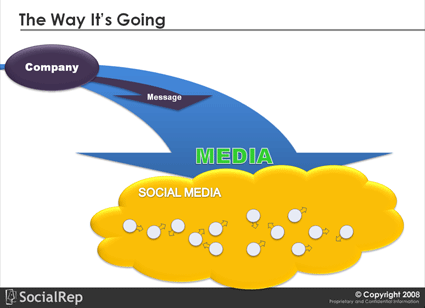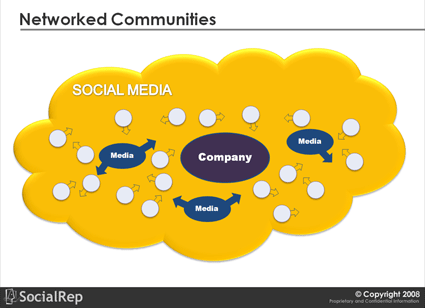I wrote in my last post about an emerging trend we’re seeing at SocialRep: prospects are telling us they’re adjusting their marketing budgets by shifting money from Public Relations to Social Media Marketing. This is a touchy subject to discuss in public; the tension between PR and Social Media professionals has been percolating for a long time. Many of the same PR pros who dismissed the significance of social media now claim to be the natural heirs to corporate social media communications, while many social media pundits see PR as entirely antithetical to authentic market dialog. Unfortunately, client-side marketers are now getting caught in the cross-fire, not sure who to trust or what programs to explore.
Having been a PR executive before leaving the industry in 2005 to launch a social media venture, I see both sides of the argument. The PR industry bears enormous responsibility for the kind of mercenary marketing and message manipulation that consumers have embraced social media to defeat. Those PR practitioners who see social media as just another new vehicle to cynically drive market influence—even while embracing a veneer of authenticity—should be continually and publicly exposed. But PR practitioners who built their agencies on the belief that effective communications and advocacy are built on a foundation of meaningful relationships and market knowledge have a lot of expertise and value to offer. The trouble is, even for good PR agencies, their DNA is fundamentally mismatched to the reality of Social Media, and even the purest intentions can’t overcome that fact if the challenge isn’t understood.
The argument about why PR is so mismatched for social media is not a discussion about the ethics of PR or its practices, which I touched on in my last post, but a discussion about the nature of media and how it’s changed. To tell that story, I’ll poach a few slides from one of my SocialRep presentations.
The most important thing to understand about social media is that it isn’t new. The technology that enables it in our wired world is certainly new, but the dynamics of social media are as old as trade itself. If you look at the history of business over thousands of years, word-of-mouth has always been the dominant form of commercial influence. It’s Darwinian. If you’re about to spend your hard-earned money on a product and you don’t want to get cheated, who will you trust to tell you the true value of the product you want to buy: the person selling it, or someone else who’s already bought one? You gain a huge survival advantage as a consumer any time you can find a third party without a vested interest to validate the value of things you want to buy.
But as populations grew, as manufacturing and transportation capabilities exploded, businesses began to reach far beyond the host communities where they were known by their neighbors, and reputations were abstracted into brands. New technologies for communicating to ever larger audiences enabled businesses to tell their brand stories in print, in packaging, on radio and eventually television. But the mode of communication was overwhelmingly asymmetrical. Since the technology for communication was enormously expensive, control was highly centralized in the hands of a few power brokers—the owners of printing presses, publishing houses, radio stations and television networks. These technologies had the power to flood a market with highly choreographed messages, while word-of-mouth only traveled point-to-point within localized community networks of families and friends. This gave rise to what I call the Media Bubble—a temporary imbalance in the flow of communication arising from the early expense of emerging technology, placing control in the hands of those who could afford it.

The Media Bubble arose because the expense of early mass communications technology ensured it was controlled by the few that could afford it.
This media bubble has been our reality for generations. All of the institutions that govern our lives, particularly business institutions, have evolved to make optimal use of this bubble—to leverage the asymmetrical control of a message that can be directed to flood a market. Think about it. Advertising is not organized as a function for connecting with customers. Advertising is organized to maintain relationships with media owners to purchase space within the stream of media that has the subscribing audience we want to reach. Public relations is not organized as a function for connecting with customers either. Public relations is organized to maintain relationships with the reporters and analysts who develop the content that goes into the stream of media that has the subscribing audience we want to reach. In both cases, our business functions are not about connecting with customers directly, but about connecting with the power brokers that control the stream of media that reaches the customers. It’s efficient, as long as that paradigm holds.
But now the media bubble is bursting. And it’s not a mystery why.

Within the media bubble, the media message is a one-way broadcast of information that floods a market of media subscribers. Corporate functions like PR and Advertising evolved to insert their message into the stream of media, or to influence its content.
As we all know from experience, as technology evolves it tends to get cheaper. Companies find ways to innovate production in order to compete for customers on price. Companies also strive to grow markets for their products to expand volume and profits. In that way, industry has inevitably worked to make the expensive communications technologies available to a wider audience at ever decreasing prices—telephones in every home, then televisions, then computers, and internet access, and mobile phones. In what some may find a poetic irony, the very institutions that enjoyed the power of controlling media couldn’t help themselves but to follow the profit motive and sell the components of power to an ever larger market of consumers. The Internet was the tipping point, when consumers and a new wave of businesses that served them assembled the pieces of a massive platform that enabled the rebirth of word-of-mouth communications on a scale that could directly challenge the primacy of corporate-controlled media.

As mass communications technology has evolved, industry developed cheaper components that could be sold profitably to the masses, which eventually made possible the massive social communications platform that allows word-of-mouth media to challenge the primacy of corporate-controlled media.
This is the world we are seeing emerge. It’s not that social media is new, even though the technology that enables it is indeed new. It’s that a media bubble that arose from the expense of communications technology is finally being challenged by an equal and opposite force of democratized communication. Social media represents a return to a broader balance of media control, a world in which consumers challenge the neatly packaged messages of marketers by validating the professed value of products with other consumers before they buy. In this environment, consumers create content that challenges the supremacy of mainstream media—in the early stages by simply writing their own reviews of products on blogs or forums, but then organizing to create their own media properties to gain subscribers based on content more tightly tuned to special interests. As these new media properties emerge, they compete for audience and revenue, undermining the business models and revenue streams of established media companies, and the media market begins to fragment.
Of course, we’re already watching this play out. The effect is what I think of as a fundamental shift from what we used to think of as market segments, often defined by the media through which members of the segment self-reference, to networked customer communities, defined by their interests through which media emerges.

In a world of social media, corporate and media interests are no longer able to asymmetrically control the media and messages. Instead, media is more fragmented and specialized, forcing corporate interests to find a way to play a meaningful role within the customer communities they serve in order to be successful.
So what does this all have to do with PR? Remember how I said the problem for PR is that their DNA is fundamentally mismatched to social media? PR is organized for the old paradigm—to influence the power brokers that control media. Their fundamental DNA is about influencing the influencers, about cultivating relationships with power brokers, not about developing dialog with consumers. Even as many PR companies try to embrace social media, they still see it through the prism of influencing the influencers rather than connecting with consumers. The challenge is not that this is inherently wrong—if as a business you can influence the influencers, that’s an efficient way to advocate on your own behalf. The challenge is that consumers, even while socially wired to follow influencers, are drawn to social media precisely because of its power to defuse the influence of influencers—to continually look behind the veil of influence and expose any inconvenient truths. Influencers will still emerge, but counterveiling truths will also emerge, and rapidly, which means businesses that only focus on trying to develop and influence the influencers will miss the more sustainable advantage of connecting authentically with consumers and playing a valued role in customer communities.
What PR is missing in its DNA is a fundamental drive to connect with customers. To listen, to learn, to play a meaningful role within a customer community. And that’s the litmus test for client-side marketers looking for someone to help them understand social media. The question isn’t how is this partner going to help me drive my message into the market to attract customers, but how is this partner going to help me develop meaningful relationships, and a meaningful role, within the customer communities that define my market. That’s not impossible for a PR company to do, but for most that I see pushing themselves forward as social media experts today, it’s still a big stretch because they don’t see the fundamental shift in the media paradigm.
At this point, I’ll say quite clearly that I think there is tremendous value PR and corporate communications can offer to the emerging practice of social media marketing. But delivering that value will require a substantial shift in philosophy that defines most PR firms. I’ll save that for my next post.









